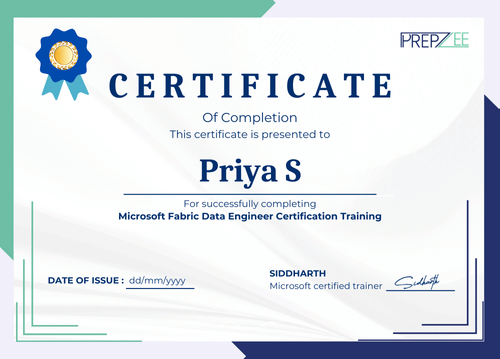













Join the course and follow their successful careers!


Nice experience, I will recommend it to all the learners who are willing to join and learn IT skills. I was able to switch my domain from non-IT to IT in a reputed MNC


Great learning experience through the platform. The curriculum is updated and covers all the topics. The trainers are experts in their respective fields and follow more of a practical approach.


Aspiring Data Engineers – Beginners seeking to start a career in data engineering.
BI Developers, ETL Developers, Data Warehouse Developers & Architects – Professionals looking to enhance their skills in data transformation and management.
Database Administrators, QA Engineers, & IT Students – Individuals wanting to expand their technical expertise in data engineering.
AI & Machine Learning Professionals – Those aiming to understand data engineering for better data handling in AI/ML projects.

The Microsoft Fabric Data Engineer online course is designed for professionals seeking to build and manage scalable data pipelines while preparing for the Microsoft Data Engineer certification. This course focuses on seamless data integration, transformation, and orchestration across Microsoft Fabric and other cloud platforms.







Microsoft Fabric is an integrated data platform designed to simplify data engineering, analytics, and artificial intelligence workflows.

Microsoft Fabric simplifies the process of ingesting data from various sources into its unified platform for analysis and transformation.

Microsoft Fabric integrates the Lakehouse architecture, combining the best features of data lakes and data warehouses to provide an efficient data management solution

The curriculum ourse,is in accordance with the requirements for clearing the Microsoft Fabric Data Engineer Certification (DP-700). You will have help with preparing a resume, potential interview questions, and a reliable certification to go with it.








1.1 What is Microsoft Fabric?
1.2 Why is Microsoft Fabric Important?
1.3 Key Features of Fabric.
1.4 Getting Started with Microsoft Fabric.
2.1 Understand Dataflows Gen 2 in Microsoft Fabric
2.2 Explore and Integrate Dataflows Gen2 in Microsoft Fabric
2.3 Integrate Pipelines in Microsoft Fabric
Hands-On:
3.1 Understand pipelines for data engineering
3.2 Use pipeline templates
3.3 Run and monitor Pipelines
Hands-On:
4.1 Introduction to real-time data analytics in Microsoft Fabric
4.2 Ingest, Transform, Store and query real-time data
4.3 Visualise real-time data in Microsoft Fabric
4.4 Introduction to Microsoft Fabric eventhouse
4.5 Work with KQL effectively
4.6 Explore materialized views and stored functions for Microsoft Fabric Certification
Hands-On:
5.1 Start learning Fabric from Basics
5.2 Understand different Real World approch to work on Fabric for data engineering
5.3 Explore the analytics capabilities of Microsoft Fabric.
5.4 Identify roles and steps to enable and utilize Fabric effectively.
6.1 Understand Real World lakehouse architecture for Data Engineering Roles
6.2 Use Microsoft Fabric for data ingestion, transformation, and analysis
6.3 Manage and utilize lakehouses for Microsoft Fabric Data Engineer Certification
Hands-On:
7.1 Integrate Apache Spark with Microsoft Fabric.
7.2 Work on notebooks to ingest, transform, and load data into a lakehouse with Spark.
7.3 Use PySpark for data analysis, transformation
7.4 Analyse real world data with Spark SQL, and structured streaming.
Hands-On:
8.1 Comprehend Delta Lake and delta tables within Fabric.
8.2 Create and handle delta tables using Spark.
8.3 Enhance the performance of delta tables.
8.4 Work on delta tables with Spark’s structured streaming.
Hands-On:
9.1 Understand medallion architecture
9.2 Work on medallion architecture for Microsoft Fabric data engineer certification
9.3 Query and report on data in the Fabric lakehouse
Hands-On:
10.1 Define data warehouses within Fabric.
10.2 Differentiate between a data warehouse and a data lakehouse.
10.3 Work on data warehouses in Microsoft Fabric.
10.4 Create and manage fact tables and dimensions in a data warehouse.
Hands-On:
11.1 Explore strategies for loading data into a Fabric data warehouse.
11.2 Construct a data pipeline to populate a warehouse in Fabric.
11.3 Load data into a warehouse using T-SQL.
11.4 Load and transform data with Dataflows Gen 2.
Hands-On:
12.1 Track capacity unit usage with the Fabric Capacity Metrics app.
12.2 Monitor current activities in the data warehouse using dynamic management views.
12.3 Observe querying trends with query insights views.
Hands-On:
13.1 Learn the concepts of securing a data warehouse in Fabric.
13.2 Implement dynamic data masking, row-level security, and column-level security.
13.3 Configure detailed permissions using T-SQL
Hands-On:
14.1 Grasp the basics of CI/CD and their use in Microsoft Fabric.
14.2 Configure version control with Git repositories.
14.3 Leverage deployment pipelines to streamline the deployment workflow.
14.4 Automate CI/CD tasks using Fabric APIs.
Hands-On:
15.1 Apply monitoring techniques to manage activities in Microsoft Fabric.
15.2 Track performance and operations with the Monitoring Hub.
15.3 Trigger actions using the Activator feature.
Hands-On:
16.1 Understand Microsoft Fabric’s security model for data engineering.
16.2 Configure permissions for workspaces and items.
16.3 Enforce granular controls to protect data.
Hands-On:
17.1 Outline administrative duties in Microsoft Fabric.
17.2 Use the Admin Center to manage settings.
17.3 Control and manage user access permissions.
Our tutors are real business practitioners who hand-picked and created assignments and projects for you that you will encounter in real work.
Integrate data from various sources (CSV, JSON, SQL) into OneLake, a unified data lake. You'll clean and transform the data before storing it, making it ready for analysis. This project will help you utilize OneLake for centralized, scalable data management within Microsoft Fabric.
Develop a comprehensive dashboard that aggregates and analyzes customer feedback from various channels to provide real-time insights into customer sentiment, enabling businesses to make informed decisions to enhance customer satisfaction.
Build a real-time event streaming platform using EventHouse, designed to handle and process live events. It simulates a system where events like user actions or IoT device signals are streamed, processed, and acted upon in real time


Prepzee's certified alumni work at Fortune 500 companies.




